| |
 |
 |
 |
 |
-GURU
|
 |
This is part four of our series on locks and keys.
- Lock Basics
- Wards and Bits
- Lever Tumblers
- Padlocks
Locks are relatively simple mechanical devices if you understand how they work and padlocks are no different.
Padlocks are made in a wide range of sizes from miniature masterpieces of only a few millimeters to huge pieces a foot or more in size.
Padlocks also range greatly in their level of security.
The vast majority are simple spring mechanisms but some are high security locks using sophisticated keys or combination locks.
Most padlocks are simple to look at but many are works of art.
The weakness of most modern padlocks is the hasp they attach to and the fact that they are exposed to simple attack with a sledge hammer or a pry bar.
Most medium quality padlocks can be quickly dispatched with a quick blow of a hammer.
I had a sister-in-law that was constantly losing her keys. She went through padlocks as if they were not there. . .
|
 |
 |
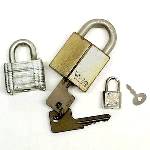
Figure 3
Click for Detail |
Padlocks come in various sizes, styles and complexities.
There are as many mechanisms as there are makers and there seen to be more types of padlocks than any other lock.
The figures above show a range of relatively modern types.
Figure 3 shows some typical locks that you are all probably familiar with.
The brass Yale is a standard quality brass pin tumbler padlock, the laminated lock to its left is an inexpensive Master warded lock and the little one is a cheap luggage lock that measures 3/4" x 1-1/4".
|
 |
 |
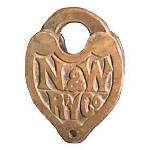
Figure 4
Click for Detail |
Figure 4 is a classic RR-switch lock from the Norfolk & Western Rail Road.
These heavy duty brass locks are a collectors item.
Forgeries are very common.
|
 |
 |
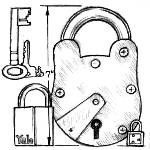
Figure 5
Click for Detail |
Figure 5 compares the standard size Yale and the little luggage lock to a large antique padlock that measures 7" (178mm).
This was an expensive six lever tumbler lock.
Many large locks had keyhole covers like this one to keep out debris.
They also keep out insects.
The lock at the top of the page was filled with mad dauber mud when I went to clean it up yesterday. . .
Very difficult to get out and makes a gritty mess of the works.
A keyhole cover would have kept the bugs out.
|
 |
 |
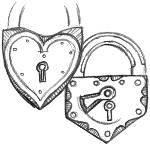
Figure 7
Click for Detail |
All the types and styles give the Locksmith room for lots of artistic creativity.
Padlocks use almost every form of metalworking including both forging and casting, and have been made from almost every common as well as precious metals.
Iron, steel and brass are most common but padlocks have also been made of stainless, Damascus, silver gold and platinum.
Padlocks are commonly made in form follows function shapes but they are also made in every geometric shape as well as that of animals, birds and fish.
|
 |
 |

Figure 8
Click for Detail |
The simplest padlock mechanism is a "spring" lock. This is a simple arrangement where the spring or a lever actuated by a spring latches the lock and a key simply pushes the spring to open the lock. Push pins, screw and the familiar bit type key are used.
In this lock the spring is a thin piece held in place by its fit in the lock case.
|
 |
 |
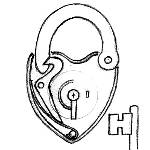
Figure 9
Click for Detail |
Ocassionally these locks will have wards. The most common types are cylindrical wards on the inside faces of the case OR as shown on the right hand side of Figure 9 a simple post.
Padlock cases are made either by forming two shallow boxes which are assembled with short shouldered studs that are riveted on the outside, OR are two flat plates with side pieces also held together with the same short riveted studs.
While the lock is being built the studs are riveted to the back of the case and the parts then fitted. When everything is complete the front cover is riveted to to the rest. Once assembled the padlock cannot be disassembled without cutting off or drilling out the rivets.
|
 |
-GURU
|
 |
The spring in Figure 9 is held in place by one of the case studs. As you can see the heart shape is a natural for this type lock .
On some locks the rivets are low pan head types and on heavy locks and on brass locks the heads are countersunk and then finished flush. Modern locks like the Yale in Figure 3 above are full of holes filled with press fit or bradded plugs that are finished flush so that you cannot see them.
|
 |
 |

Figure 1
Click for Detail |
I obtained this lock when I was asked to open a shed for my next door neighbor.
She handed me a string of keys and said she could not find the right one. . .
There was no key to fit so I picked it with a piece of coat hanger wire.
The lock was old, rusted and had been painted over several times.
She gave me the padlock since she had no key.
And then the lock has sat for another 25 years hanging from a nail.
I suspect this lock is at least 50 years old.
This lock has one of the more unusual padlock mechanisms.
You will note at the top of the page that it does not have a catch on the end of the shackle.
Just a point.
The locking action occurs on the rotating end of the shackle.
|
 |
 |
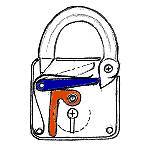
Figure 6
Click for Detail |
(The is following is my best guess without disassembling the lock).
In this lock there are two levers.
The blue lever is held down by a leaf spring and bears against the end of the shackle.
As long as the lever is below a straight line between its pivot and the shackle's, the shackle cannot move and pressure on the shackle makes the lock tighter.
The red dog-legged lever lifts the locking lever when the bit key is rotated.
The spring pressing on the straight lever returns both levers to the locked position when the shackle is closed.
In this lock the key can only be rotated about 120° in either direction.
|
 |
 |
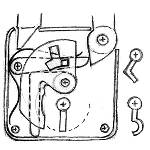
Figure 10
Click for Detail |
This lock MAY have lever tumblers.
I have picked this lock three or four times recently in order to clean and photograph it.
It was NOT easy to pick and it felt like there were possibly one or two levers (probably rusted in place).
Figure 10 shows how lever tumblers would work in this lock.
The levers rotate on the same center pin as the dog-legged lever.
When they are rotated clockwise far enough for the post on the locking lever to move in the slot the key should contact the dog-legged lever and lift the locking lever.
This is a relatively simple mechanism that can be made with common shop tools and a jewelers saw (to make the lever tumbler).
|
 |
 |
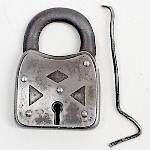
Figure 2
Click for Detail |
An interesting design element of this lock is the pierced front plate.
It appears to be decorative element but may be additional "armor" to strengthen the lock's sheet metal case.
(Pick used to open the lock shown).
I've been warned recently that it is ilegal to carry lockpicks in many states unless you are a registered locksmith.
Even though I have some commercial lock picking tools I most often end up making picks when needed.
A coat hanger, plires and a hammer, sometimes a file. . .
Kind of like te infamous "bomb making tools", a soldering iron and multimeter. . .
|
 |
 |
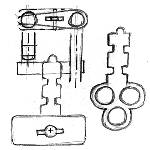
Figure 11
Click for Detail |
The little luggage lock shown in figures 3 and 5 is a VERY simple spring lock.
The spring is a simple pinched "U" shape that engages in slots in one end of the shackle.
A flat key is inserted between the legs of the spring and twisted to spread the ends of the spring and unlock the shackle.
In this type lock the bottom of the lock is usually the only "ward" but there is another one in this lock.
This is usually a rib cast into the case to retain the spring and it doubles as a ward.
|
 |
 |
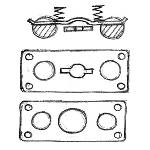
Figure 12
Click for Detail |
In inexpensive laminated ward locks (the ones with flat or serrated keys),
the locking bar is a separate piece that engages slots in both legs of the shackle.
It is usually held in place by two light coil springs made of bronze or stainless steel.
The plates shown are ward a plate and a clearance plate.
Arranging the ward plates differently in each lock is simple to do and produces a small number of variations.
I do not recommend making hand made locks by this method but it is interesting to know and can be applied in other types of locks.
However, it might make a stout and attractive old style padlock with the plates laminated front to back. Alternate brass and steel. . .
|
 |
-GURU
|
 |
Questions, Comments?
|
 |
Paul B
|
 |
When these locks were originally forged, did the smith lubricate the internal parts prior to riveting on the face or were the parts left dry to prevent them from getting gummy?
|
 |
-GURU
|
 |
Paul, generally they were lightly oiled to prevent rust. Ocassionally there are places in locks that are greased but normally the mechanisms are designed to operate dry.
|
 |
PF
|
 |
another splendid demo Good Guru...thanks!
|
 |
Paul B
|
 |
Are these locks generally made from mild steel or iron or are some of the parts made from tool steel?
|
 |
-GURU
|
 |
Most "iron" lock parts are made of mild steel.
The exception being that shackles of good padlocks are hardened and tempered medium carbon steel or heat treatable stainless steel and the the springs are high carbon steel.
|
 |
PF
|
 |
Guru... This infers that most of the bumps and serrations on keys are for decoration. . is that right?
|
 |
-GURU
|
 |
Pete, most of the cuts in keys are functional but in many cheap locks they are all the same. In luggage locks there are only a dozen or so that fit all good quality suitcases. . and only 3 or 4 per popular brand like Samsonite.
|
 |
-GURU
|
 |
Many of the old spring locks and cabinet locks used a plain rectangular bit key. Sometimes the locks were warded and required a few ward notches. A lot depends on the age and the quality of the lock. The types I am showing here are the simple ones to make.
|
 |
PF
|
 |
A little alarming, thanks Guru.
|
 |
Paul B
|
 |
Fantastic Demo... Thank you!!!
|
 |
|
 |
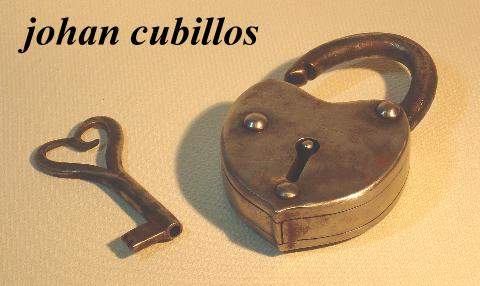 Padlock by Johan Cubillios, Costa Rica based on the above demo.
Padlock by Johan Cubillios, Costa Rica based on the above demo.
|
 |
|
 |

Another hand made padlock and key - by mathew . . . ?
|
 |
|
 |

Ancient style brass spring padlock. The key is "I" in cross section and squeezes the springs in to release.
|
 |
|
 |
Links
|
 |




Padlocks
Demonstration by Jock Dempsey
October 30, 2002
- Lock Basics
- Wards and Bits
- Lever Tumblers
- Padlocks
Locks are relatively simple mechanical devices if you understand how they work and padlocks are no different.Padlocks are made in a wide range of sizes from miniature masterpieces of only a few millimeters to huge pieces a foot or more in size. Padlocks also range greatly in their level of security. The vast majority are simple spring mechanisms but some are high security locks using sophisticated keys or combination locks. Most padlocks are simple to look at but many are works of art.
The weakness of most modern padlocks is the hasp they attach to and the fact that they are exposed to simple attack with a sledge hammer or a pry bar. Most medium quality padlocks can be quickly dispatched with a quick blow of a hammer. I had a sister-in-law that was constantly losing her keys. She went through padlocks as if they were not there. . .
Figure 3
Click for Detail
Figure 3 shows some typical locks that you are all probably familiar with. The brass Yale is a standard quality brass pin tumbler padlock, the laminated lock to its left is an inexpensive Master warded lock and the little one is a cheap luggage lock that measures 3/4" x 1-1/4".
Figure 4
Click for Detail
Figure 5
Click for Detail
Figure 7
Click for Detail
Padlocks are commonly made in form follows function shapes but they are also made in every geometric shape as well as that of animals, birds and fish.
Figure 8
Click for Detail
In this lock the spring is a thin piece held in place by its fit in the lock case.
Figure 9
Click for Detail
Padlock cases are made either by forming two shallow boxes which are assembled with short shouldered studs that are riveted on the outside, OR are two flat plates with side pieces also held together with the same short riveted studs.
While the lock is being built the studs are riveted to the back of the case and the parts then fitted. When everything is complete the front cover is riveted to to the rest. Once assembled the padlock cannot be disassembled without cutting off or drilling out the rivets.
On some locks the rivets are low pan head types and on heavy locks and on brass locks the heads are countersunk and then finished flush. Modern locks like the Yale in Figure 3 above are full of holes filled with press fit or bradded plugs that are finished flush so that you cannot see them.
Figure 1
Click for Detail
This lock has one of the more unusual padlock mechanisms. You will note at the top of the page that it does not have a catch on the end of the shackle. Just a point. The locking action occurs on the rotating end of the shackle.
Figure 6
Click for Detail
In this lock there are two levers. The blue lever is held down by a leaf spring and bears against the end of the shackle. As long as the lever is below a straight line between its pivot and the shackle's, the shackle cannot move and pressure on the shackle makes the lock tighter.
The red dog-legged lever lifts the locking lever when the bit key is rotated. The spring pressing on the straight lever returns both levers to the locked position when the shackle is closed. In this lock the key can only be rotated about 120° in either direction.
Figure 10
Click for Detail
Figure 10 shows how lever tumblers would work in this lock. The levers rotate on the same center pin as the dog-legged lever. When they are rotated clockwise far enough for the post on the locking lever to move in the slot the key should contact the dog-legged lever and lift the locking lever.
This is a relatively simple mechanism that can be made with common shop tools and a jewelers saw (to make the lever tumbler).
Figure 2
Click for Detail
(Pick used to open the lock shown).
I've been warned recently that it is ilegal to carry lockpicks in many states unless you are a registered locksmith. Even though I have some commercial lock picking tools I most often end up making picks when needed. A coat hanger, plires and a hammer, sometimes a file. . . Kind of like te infamous "bomb making tools", a soldering iron and multimeter. . .
Figure 11
Click for Detail
In this type lock the bottom of the lock is usually the only "ward" but there is another one in this lock. This is usually a rib cast into the case to retain the spring and it doubles as a ward.
Figure 12
Click for Detail
The plates shown are ward a plate and a clearance plate. Arranging the ward plates differently in each lock is simple to do and produces a small number of variations. I do not recommend making hand made locks by this method but it is interesting to know and can be applied in other types of locks. However, it might make a stout and attractive old style padlock with the plates laminated front to back. Alternate brass and steel. . .
Another hand made padlock and key - by mathew . . . ?
Ancient style brass spring padlock. The key is "I" in cross section and squeezes the springs in to release.
Links
iForge is an Andrew Hooper Production
Copyright © 2002, 2009, 2011 Jock Dempsey, www.anvilfire.com
Webmaster email: webmaster at anvilfire.com